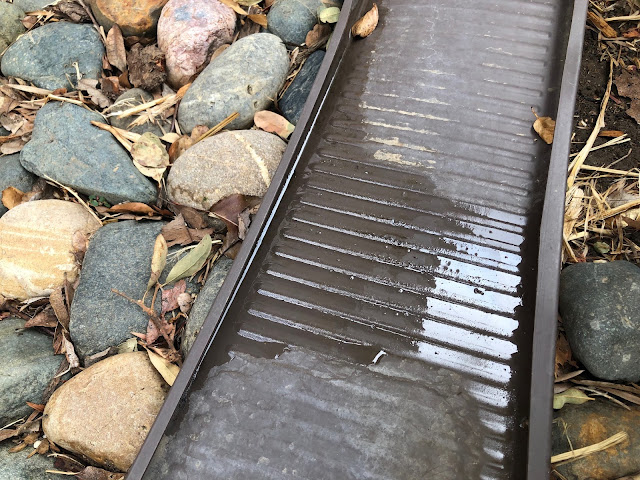
Storms could produce one-two punch, up to 2.5 inches rain

|
|
This downspout splash block got just a bit of water this morning but it's likely
to be flowing during the rainstorms starting Thursday. (Photo: Kathy Morrison)
|
Turn off the sprinklers! Our record dry spell is officially over – and the first big storm of our new water year is on its way.
Wednesday’s drizzly conditions are just a warm-up. According to the National Weather Service, Sacramento can expect a wet one-two punch, starting Thursday.
“Periods of heavy to moderate rain are possible late Thursday into Friday with our next storm system,” tweeted the NWS Sacramento office on Wednesday morning. “These (showers) could bring potential ash flows and debris flows to recent burn scars. They could also bring morning commute issues. The heaviest rain is expected north of I-80.”
Sacramento Valley is expected to get 0.5 to 1.5 inches in this first wave, says the weather service. Foothill areas could get 2 to 4 inches.
Expect “ponding of water on roadways and some minor flooding of poor drainage areas,” the weather service added.
Saturday may be showery, but mostly dry. Then comes another, colder storm on Sunday with rain expected through Tuesday. That storm is expected to drop at least an inch on Sacramento and snow in the mountain passes.
That adds up to 1.5 to 2.5 inches for Sacramento. If these storms deliver as expected, Sacramento’s October rain total will easily top its historical average of 0.95 inches.
These storms follow the longest rainless period in Downtown Sacramento history – 212 days. Before Sunday night’s light rainfall, the weather service’s Downtown Sacramento monitors had not recorded any measurable precipitation since March 19.
Details: https://www.weather.gov/sto/.
Comments
0 comments have been posted.Sacramento Digs Gardening to your inbox.
Sites We Like
Garden Checklist for week of April 21
This week there’s plenty to keep gardeners busy. With no rain in the immediate forecast, remember to irrigate any new transplants.
* Weed, weed, weed! Get them before they flower and go to seed.
* April is the last chance to plant citrus trees such as dwarf orange, lemon and kumquat. These trees also look good in landscaping and provide fresh fruit in winter.
* Smell orange blossoms? Feed citrus trees with a low dose of balanced fertilizer (such as 10-10-10) during bloom to help set fruit. Keep an eye out for ants.
* Apply slow-release fertilizer to the lawn.
* Thoroughly clean debris from the bottom of outdoor ponds or fountains.
* Spring brings a flush of rapid growth, and that means your garden is really hungry. Feed shrubs and trees with a slow-release fertilizer. Or mulch with a 1-inch layer of compost.
* Azaleas and camellias looking a little yellow? If leaves are turning yellow between the veins, give them a boost with chelated iron.
* Trim dead flowers but not leaves from spring-flowering bulbs such as daffodils and tulips. Those leaves gather energy to create next year's flowers. Also, give the bulbs a fertilizer boost after bloom.
* Pinch chrysanthemums back to 12 inches for fall flowers. Cut old stems to the ground.
* Mulch around plants to conserve moisture and control weeds.
* From seed, plant beans, beets, cantaloupes, carrots, corn, cucumbers, melons, radishes and squash.
* Plant onion sets.
* In the flower garden, plant seeds for asters, cosmos, celosia, marigolds, salvia, sunflowers and zinnias.
* Transplant petunias, zinnias, geraniums and other summer bloomers.
* Plant perennials and dahlia tubers for summer bloom.
* Mid to late April is about the last chance to plant summer bulbs, such as gladiolus and tuberous begonias.
* Transplant lettuce seedlings. Choose varieties that mature quickly such as loose leaf.